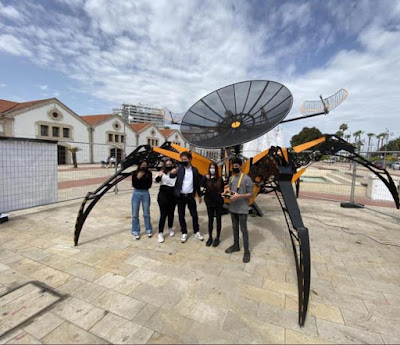Filenews 26 March 2021
At 12 noon, the largest educational robot in the world, "ASTRO 1", designed by students of PASCAL English School Larnaca, will be launched from Europe Square in Larnaca, bringing to the atmosphere the experiments of 1700 students from 27 schools in Cyprus.
As the Hopeful Anastasios Professor Pascal English School Larnaca / Researcher of the Eratosthenes Centre of Excellence said "today around 12 noon will take place from Europe Square in Finikoudes in Larnaca, the launch of the world's largest educational robot "ASTRO 1", built by students of Pascal Private English School in Larnaca. The launch will take place using a meteorological balloon, from the Department of Meteorology which we warmly thank for the great help it has offered us over the last three years."
He added that "the launch of the robot will take place live and those interested can watch it from You Tube by visiting the Cyprus Space Up 2021 website. The robot will travel for three hours, reach an altitude of about 90 thousand feet, withstand temperatures of minus 50 degrees Celsius and high solar radiation for six hours."
He also said that "ASTRO 1" is a Steam training platform that combines robotics and space with which students can build devices to add different functions to it. At the same time teachers and teachers have the opportunity to use the platform in order to combine material of the Ministry of Education, Culture, Sport and Youth of Cyprus with the robot and to show students in practice how the theory becomes a reality for problem solving".
He also noted that "the experiments of 1700 students from 27 schools in Cyprus will be on the construction. When the satellite returns to Cyprus, the students will analyse the findings in order to draw conclusions about the accuracy of their experimental predictions."
Asked about the characteristics of the robot, Mr. Anastasiou replied that "one of its most beautiful features is the large disk located above the robot that is rotating and therefore we can today take the video from the stratosphere through the robot. The "ASTRO 1" weighs 1400 kg, has a diameter of about ten meters, three meters high, its legs move with 24 hydraulic motors, while its unique design, like a spider, allows it to move easily, and be placed on any surface using minimal energy".
He also noted that "we have already come up with an educational model that we will implement next year in order to give all students the opportunity to build devices that will give "ASTRO 1" additional functions".
Asked to say how much the construction of the robot cost, Hopeful Anastasiou said that "whatever it cost is worth it because the robot is not only for one school and one class but for 27 schools and 1600 students. As an investment in education, the robot will deliver thousands of results to students."
For his part, Pascal English School student Kyriakos Timotheou said that "through the week of space we had at school, we were trying to come up with an idea to make the subject of space – robotics more interesting to the world. So after discussions we had with my classmates we thought about building "ASTRO 1".
He added that he had the role of "3D design and printing of the robot, so that we can see potential problems and be able to improve them so that we get today's result. The robot also acts as a mobile satellite station from which students can take live video from micro-satellites they send into the stratosphere."
It is noted that today with the launch of the robot and the holding of a Space Workshop, the activities of the First Cyprus Space Training Week, which began on Monday 22 March organized by the non-profit Cyprus Space Foundation, the project 'EXCELSIOR' H2020 Widespread Teaming and the Centre of Excellence 'ERATOTHENIS' of the Cyprus University of Technology, culminate.
Supporters of the effort are the Department of Meteorology, the Cyprus Youth Organisation, pascal space centre and Pascal English School Larnaca".
Source:CYPE
